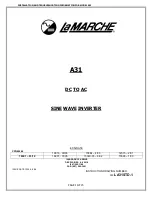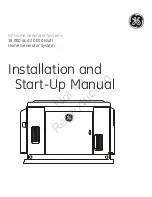
29
Component Identification and Explanation
Explanation of Functions and Welding Terms
by a HF system similar to the ignition system on older automobiles.
A high voltage, low amperage current is created which jumps from
the Tungsten to the work piece when activated. Once the machine
sends the HF impulse to the torch, the HF energy jumps, the welding
arc will initiate after the HF establishes a current path and the HF
shuts off. On this unit if the HF stays on, but does not start an arc or
an arc is not sensed, the unit will stop output of the HF after approxi-
mately 2 to 3 seconds. If this happens an error code
“
E05
”
will be
displayed temporarily, meaning the switch is either stuck closed, or
the arc has been activated too long without an arc start. This is a
safety feature as HF energy can affect surrounding electronic items.
Hot Start. This setting controls the intensity of the arc start by con-
trolling the initial amps at the start of the weld cycle. It is used to
improve arc starting and reduce the time needed to establish a pud-
dle and helps to prevent porosity at the beginning of the weld. This
can refer to either TIG or Stick. The Hot start is controlled through
the
“
Start Amps
”
of the welder. In TIG mode, this follows the pre
-
flow control cycle.
Lift Start. Lift start requires touchdown and lifting up of the Tungsten
to start the Arc. It is usually used only with DC output since some
contamination of the tungsten is possible. But it can also be used
with AC where HF energy is prohibited, such as in a hospital envi-
ronment.
There are two types of Lift Start.
The first is a live lift start.
This means the tungsten is always electrically live until the arc is
started. When the tungsten is touched to the metal, continuity is
sensed and the welder sends welding power as soon as the continui-
ty is broken. This unit does not have this type of Lift Start. Some of
our units have this type start, but it is not featured on this machine.
If you need this type of start on a welder, contact Everlast for other
product information. The other type of lift start is a
“
remote lift start
”.
This is the type this unit has unit has. It functions essentially the
same except, the tungsten is not electrically live and the torch switch
or foot pedal must be used to make the torch live. This is a safer
form of lift start and helps prevent accidental starting of the arc. It
also means that the start type can be used with the welder program-
ming in 2T and 4T mode, or with the foot pedal.
Post Flow. Post Flow is the amount of time (in seconds) that the
shielding gas flows after the arc is terminated. This is an important
function. The flow of shielding gas after welding is stopped helps to
1) Cool the torch and tungsten and prevents oxidation of the tung-
sten as it cools. 2) Provide cooling and shielding while the weld
puddle solidifies and cools. This helps to prevent the weld from
forming porosity and prevents oxidation of the weld as it cools. Post
Flow should be increased at the Amperage increases. For simple
calculation, add one second of Post Flow for every 15 to 25 Amps
used. At a minimum, 2 to 3 seconds should always be used. To
properly use Post Flow, the torch should be held in place over the
weld after termination until the gas shuts off.
Pre Flow. Pre Flow is the amount of time (in seconds) that the
shielding gas flows before the weld starts before the arc initializes.
This protects the tungsten, and helps to establish an arc more quickly
by surrounding the tungsten and work with more easily ionized gas
so that arc starts are more efficient. It also allows time for the gas
How Do I Perform a Lift Start?
Rest the edge of the cup on the work piece so that the tungsten
is slightly off the work. Press the trigger or foot pedal. Quickly
rotate the tungsten to the work using the cup edge as a pivot.
A small spark may be noticed as it touches. Once the Tungsten
touches, quickly and seamlessly rotate the cup back to draw an
arc.
Raise the cup to establish the arc to
1/8”
or less in height.
Allow the puddle to form and move the torch forward maintain-
ing 1/8 or less height.
≤
1/8”
Weld Height
3
2
1
4
NOTICE:
The arc start will be delayed by the amount of time set for the Pre
Flow. This is normal and not a defect.
Why Doesn
’
t This Unit Have
Continuous HF on AC?
Regardless of wave form, the High Frequency (HF) on this welder is only
used to start the arc. Once the arc is started, the HF shuts off when the arc
transfers. This is possible, because of the fast switching times that there is
virtually no
“
off
”
time of the arc as there is with a transformer welder oper-
ating on 60Hz. The transformer welder doesn
’
t modify or change that
frequency. So, in a transformer welder, the arc
“
outs
” 60
times a second
as it changes polarity 60 times a second. This is why HF is used to over-
lay the arc to provide stability and a continuous arc as the arc hits a
“
dead
”
spot. Inverters take the 60 Hz (50Hz in some regions), break it down,
chop it up, and recompose the welding arc and can deliver switching
speeds so fast, that even welding at AC Hertz frequencies below 50 or 60
Hz, the arc has no discernable
“
time off
”
and no outages, so the arc re-
mains relatively stable and smooth without the HF overlay.
Содержание PowerPro 164Si
Страница 46: ...46...
















































